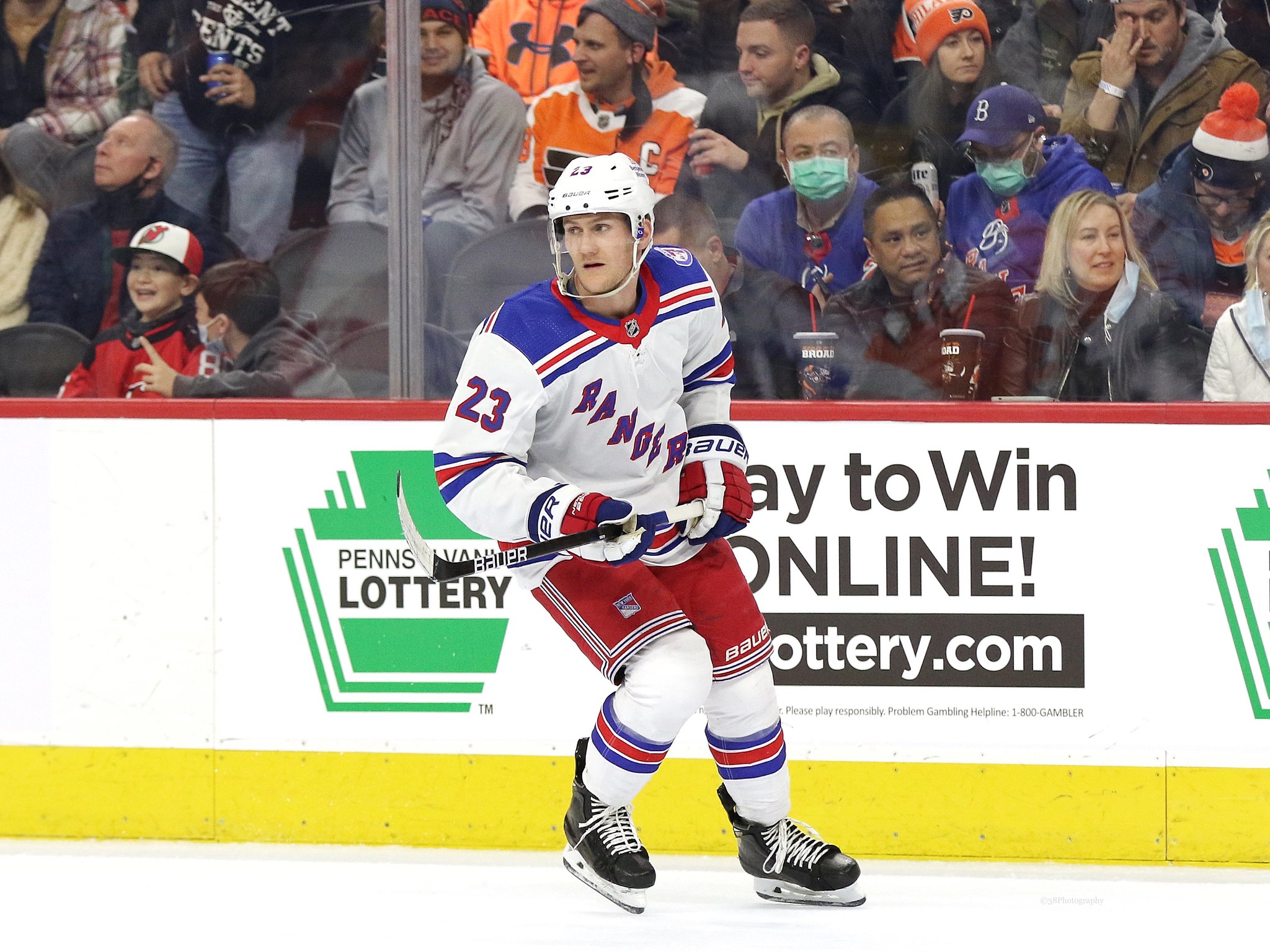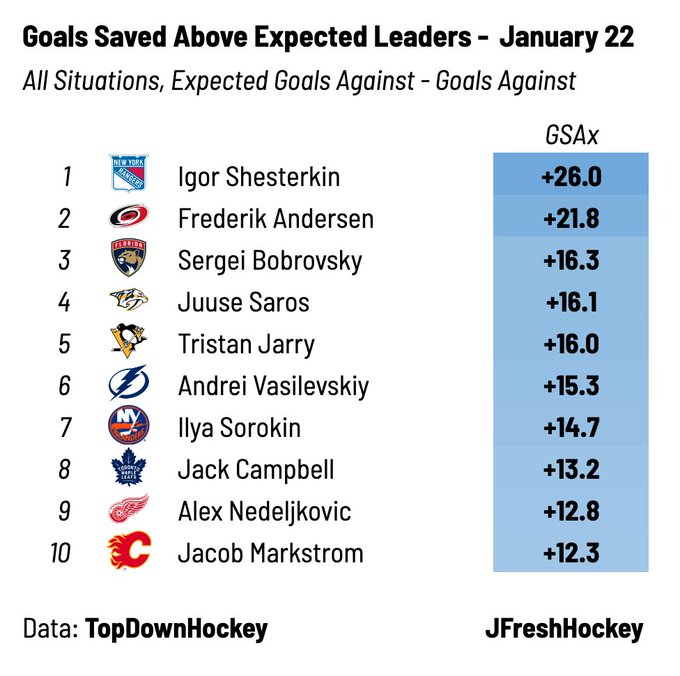As the NHL is rapidly approaching the halfway mark of the 2021-22 season, there is no better time to reflect on what’s transpired during the first half of the campaign. While many of the usual suspects have unsurprisingly landed atop their respective divisional standings, a few teams have exceeded expectations on the back of superb goaltending and unsustainable conversion rates. That’s not to say that these are suddenly “bad” teams, but the percentages make them a bit of a mirage. With that, here are three teams that look set to take a step back in the second half of the season – let’s dig in.
New York Rangers
Let’s kick off this article with what is sure to be a controversial pick in the New York Rangers, who currently lead the Metropolitan Division and sit fourth overall in the NHL with a record of 27-11-4. New York’s 53-win, 113-point pace this year ties their franchise records in each department, both of which were set in the 2014-15 season. Although the mini-rebuild initiated by the now-departed pair of John Davidson and Jeff Gorton looks to be complete, the team’s formidable record is built on unsustainable percentages and several spectacular individual performances.
Their blueline lynchpin in Adam Fox is enjoying a campaign worthy of another Norris Trophy, leading all defensemen in scoring with 45 points in 42 games, representing an 88-point pace over a full season. His continued dominance is unsurprising, even if his production rate is on track to set a new points record by defensemen in the 21st century, currently the 83-point campaign produced by Brent Burns in 2018-19.

Perhaps more surprisingly is the offensive outburst of power forward Chris Kreider, whose 29 goals and 42 points in 42 games both symbolize career-high paces. Kreider is currently tied with Alexander Ovechkin for the NHL’s goal-scoring lead, and he’s already set a new personal best in goals with 40 games remaining.
Even though Kreider’s underlying metrics point to an improved offensive skill set (he’s posted career-best 5v5 shot- and scoring chance rates), his 22.1% shooting percentage (SH%) is significantly higher than his 14.7% career average. Further, he’s only tied for seventh in even-strength scoring (13) and leads the NHL in power-play goals, a sign that he may be benefitting from the numerical context inherent to the man-advantage. I don’t mean to disparage Kreider as he’s a legitimate offensive threat, but he’s running hot, and some wariness should be exercised before expecting his explosive rate of conversion to continue.
Yet, no one on the Rangers’ roster has a greater claim to the team’s prominence in the standings than goaltender Igor Shesterkin, who is submitting a Vezina Trophy caliber performance in his third NHL season. The Russian netminder has been virtually unbeatable, ranking highly save percentage (second), goals-against average (third), and goals saved above expected (first) among goalies with a minimum of 10 games played. When only considering team starters, no one comes close to Shesterkin, and I’d argue he deserves a Hart Trophy nod for his superhuman efforts this season.
Simply put, the Rangers are awful at 5v5 and depend on Shesterkin to bail them out far too often for an organization hoping to be a legitimate Stanley Cup contender. They are porous defensively, conceding remarkably high rates of shot attempts (29th), scoring chances (30th), high-danger chances (29th), and expected goals (29th). Further, they rank dead-last in terms of their share of scoring chances (43.1%) and expected goals (44.4%), indicating they aren’t driving much offense outside of their sky-high finishing.
Despite the commendable performances of several individuals, the Rangers look like a flimsy house of cards, with a collapse looking imminent. Of course, impenetrable goaltending and strong special teams (both within the top eight by efficiency) can mask their inconsistencies, and it wouldn’t be the first time it’s happened in the long history of the NHL. Can New York stave off the whiplash of regression?
St. Louis Blues
In keeping with the theme of weak 5v5 play being disguised by notable individual performances, the St. Louis Blues represent another likely candidate for regression in the second half of the season.
This season has seen Jordan Kyrou finally deliver on his breakout potential, scoring 40 points (15 goals, 25 assists) in 36 games to lead St. Louis in scoring. His outbursts are complemented by regular contributions from offseason addition Pavel Buchnevich (36 points in 36 games) and a resurgent Vladimir Tarasenko (35 in 36), giving the Blues the weapons needed to overcome their structural deficiencies.

Still, the Blues lead the NHL in a metric known as PDO (it doesn’t stand for anything), which combines a team’s SH% and SV% at 5v5 to present a cumulative value. The idea is that the further a team moves away from a value of 1.000 (in either direction), the greater the likelihood that their results are unsustainable. St. Louis ranks in the top eight for both SH% (sixth) and SV% (eighth), resulting in a PDO value of 1.020.
Despite scoring 54.2% of actual goals at 5v5 (eighth in the NHL), St. Louis only controls 48.3% of shots (22nd), 47% of expected goals (24th), and 44.8% of high-danger chances (28th), depicting a wide discrepancy in process versus results. Individual talent can win out in the short-term (such as in a single playoff series or an entire postseason), but such poor underlying metrics bode poorly for long-term success.
You May Also Like:
Apart from their 5v5 numbers, the play of Jordan Binnington – whose .906 SV% in 2021-22 marks the third consecutive season in which his SV% has declined – is particularly worrying. Luckily, the Blues have been able to count on their backups in Ville Husso (.938 SV% in 11 games) and Charlie Lindgren (.958 SV% in five games) to perform in spot duty, but their defensive holes (28th in xGA/60) do little to insulate their netminders.
St. Louis’ individual brilliance and effective special teams’ units are keeping them afloat for now (second-best power-play and fourth-best penalty kill), but they have to settle their even-strength play to topple the Western Conference superpowers.
Anaheim Ducks
The third dishonorable mention on this list is the Anaheim Ducks, the Californian upstarts who have ridden their youth movement to second place in the Pacific Division with a record of 20-16-7. The team’s .547 points percentage (PTS%) is the franchise’s highest since the 2017-18 season, the last time the Ducks appeared in the postseason.
Their pair of dynamic rookies in Trevor Zegras (29 points in 37 games) and Jamie Drysdale (18 in 43) have complemented Troy Terry’s breakout campaign (22 goals this season) and Ryan Getzlaf’s late-career resurgence (24 points in 35 games). Even while taking positive steps forward this season, the Ducks’ strong start could fade quickly, with their numbers under the hood setting off alarm bells in Orange County.

Anaheim struggles to consistently direct the flow of play at 5v5, only controlling 49.1% of scoring chances (21st in the NHL) while owning a 48.1% share of expected goals (also 21st), which is a proxy for chance quality. Those numbers are more indicative of a playoff bubble team rather than one entrenched in an automatic divisional spot.
Further, the Ducks’ 47.2% share of actual goals is a poor omen, especially considering the outstanding performances put forth by their goaltending contingent this season on the defensive side of that ledger. Their primary tandem of John Gibson and Anthony Stolarz has held down the crease admirably (15th and 16th in SV% respectively – minimum five games played), contributing to the sixth-best team SV% this season (.915). As has been a common trait among the teams on this list, dependable goaltending has buoyed an otherwise suspect structure, and time could be grinning out on one of the NHL’s most thrilling surprises this season.
Even if Anaheim rapidly tumbles out of playoff contention, the Calder Trophy caliber campaigns enjoyed by their franchise cornerstones are foundational building blocks for the franchise. Add in the haul of assets that their collection of pending free agents likely commands at the trade deadline and the Ducks look set to be a Western Conference powerhouse in the near future.
Can These NHL Teams Survive Regression?
Although hitting the midseason mark means that we’ve accumulated a significant amount of statistical evidence as to what teams are, it’s still limited in some respects. Even a full 82-game season is sometimes short enough to disguise a team’s flaws, and it’s difficult to conclusively parse out the NHL’s true competitive hierarchy. I could be off base in my conclusions, but it’s likely that these three teams should experience at least a minor downswing in results during the second half of the season – only time will tell.
Data courtesy of Hockey Reference, MoneyPuck, Natural Stat Trick, and the NHL. Statistics are accurate as of January 23rd.

Marko is an aspiring sportswriter with a passion for crafting stories while using a combination of the eye-test and (shudder) analytics, which is complemented by an academic background in criminology and political science.
When not covering the Colorado Avalanche and Pittsburgh Penguins for The Hockey Writers, he can also be found pouring countless hours into various sports video games franchises, indulging in science fiction novels, and taking long runs around his neighbourhood.
Marko can be reached through his personal blog at unexpectedgoals.ca, and you can yell at him by following him on Twitter and other social media seen under articles like this one.

